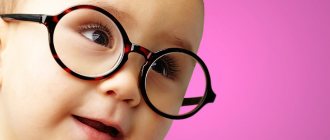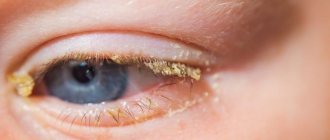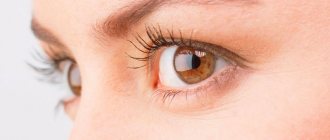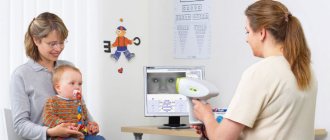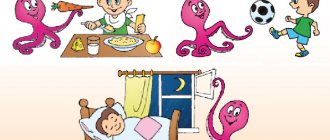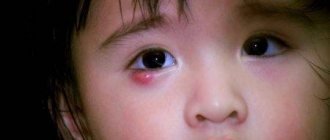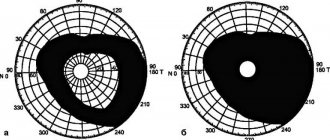Features of cognitive activity in children with visual impairments
The cognitive activity of children with visual pathology has not yet been studied fully and comprehensively. And yet, the research available on this problem makes it possible to give, although incomplete, a characterization of the formation of cognitive processes in these children.
The development of cognitive activity of blind children occurs according to the laws of the formation of the psyche of children with normal vision, however, visual impairments change its dynamics and introduce some originality.
The formation and development of the cognitive process in a blind child of preschool age depends on the nature of the pedagogical influence, a significant role in which belongs to the content and organization of training aimed at strengthening independence, active assimilation of techniques and methods of cognition.
Early correction of deficiencies in the development of cognitive activity in the conditions of special education and training allows children to successfully master knowledge, abilities and skills in the future, significantly reducing their difficulties in understanding the surrounding reality.
Self-learning and spontaneous development of cognitive processes in children deprived of vision occurs much more slowly compared to their sighted peers, which is a consequence of their lack of visual imitation, visual control over performing actions, and the complexity of organizing a feedback system. Improving cognitive activity in the blind in the preschool period using the necessary psychological and pedagogical correction is effective, although there is a delay in the rate of development.
In preschool age, the development of all types of sensory-perceptual activity is observed, but it occurs unevenly. Thus, we can note a significant – compared to tactile – development of auditory perception. Already at early preschool age (3–4 years), children have a clear and relatively accurate differentiation of sounds, with a certain verbal characteristic of them.
The development of auditory perception proceeds in the direction of integration of auditory stimuli, the latter being correlated with objects and actions, i.e. the sound properties of objects acquire signaling significance. The formation of hearing as a means of remote control over one’s actions and the actions of others has a compensatory value. This is the main trend in the development of auditory perception.
In middle preschool age, a blind child only notes the action; in older preschool age, a verbal and logical comprehension of his own experience is already outlined, which indicates the formation of analyzing auditory perception.
At preschool age, tactile recognition of even well-known objects is very imperfect. Blind children of primary preschool age correctly recognize presented objects in 28% of cases, and older children - in 75%. Throughout almost the entire preschool age, tactile perception retains a global, poorly differentiated character.
The development of tactile perception during this period occurs in the direction of the formation of generalized tactile images, which is closely related to the development and formation of the generalizing function of speech. In this case, mastering specific tactile examination techniques unique to each age group is of great importance.
The development of residual vision, which provides significant assistance to the child in the tactile perception of objects, is of great compensatory importance. The development of the mental processes of a blind child depends on the progress of the development of his objective actions. In visually impaired children, despite their defective vision, the main means of perceiving the world, like in normal-seeing children, is vision.
Visual perception is the mental process of reflecting objects and phenomena of the surrounding world in the human mind with their direct impact on the organ of vision. When an object is exposed to the eye, a very complex transformation of “the energy of external stimulation into a fact of consciousness” occurs, i.e. into the image of an object that a person perceives.
It is possible to distinguish a perceived object from objects similar to it only with subtle, accurate and rapid differentiation of signals entering the brain. This process is possible with sufficient anatomical and functional maturity of the visual analyzer.
The basis of the activity of the visual analyzer , as well as analyzers of other modalities, is the interaction of the first and second signal systems, due to which human perception is meaningful, generalized and arbitrary in nature, which differs from the perception characteristic of animals.
The physiological basis of visual perception is the interaction of various functions of the visual analyzer and the formation on this basis of conditioned reflexes to complex complex stimuli, as a result of which a person develops a complex image of an object with all the diversity of its properties and parts. In this case, previously formed temporary neural connections are of significant importance, and thus past experience influences the content and nature of perception.
The formation of an image of a visually perceived object is ensured both by the sensory functions of the visual analyzer and by the most complex analytical and synthetic activity in the human cerebral cortex. The image of a perceived object arises on the basis of two opposite, but closely interacting nervous processes: the finest differentiation of acting stimuli and their integration by combining, merging, linking excitations that arise in many nerve cells. Repeated perception of an already familiar object occurs instantly due to the activation of nerve connections previously formed in the cerebral cortex.
When perceiving an object, the corresponding experience (apperception) of the perceiving person matters. If he is familiar with the subject in general terms, then the emerging image will be fuzzy and vague. Speech, the word by which an object is named, plays a huge role in perception. Consequently, an object is reflected in a person’s consciousness through sensory cognition and verbal designation.
Perception is a complex multisensory process that includes a number of perceptual and recognition actions. It has the stages of object detection, discrimination and selection of informative features, formation of a perceptual image, its identification and categorization, detection and selection of informative features of objects. The adequacy and completeness of the emerging perceptual images depend on orientation-research activities.
Visual perception includes the work of sensory (sensitive), motor and speech mechanisms: visual influence and previous experience, human interest and mental activity. He must see the whole, consisting of the totality of its parts, identify the main features among the secondary ones, compare them with the category of objects known to him, abstract the essential features from the secondary individual characteristics inherent in this particular object, i.e. see the general in the particular and the special.
Thus, A. Binet believes that the nature of perception of plot pictures depends on the age of the child, and distinguishes three stages in such perception:
- enumeration stage (or subject),
- description stage (or action stage)
- the stage of interpretation of the perceived picture (the stage of relationships).
However, research by Soviet psychologists has established that the nature of the story is determined not by the age characteristics of the child, but mainly by the content of the picture, the clarity and expressiveness of the execution of the plan, the dynamism or static character of the characters depicted in the picture. Of great importance is the child’s level of preparedness for such complex work as the ability to look at a picture. The nature and form of the questions that the adult addresses the child are of no small importance.
The facts obtained by various researchers while studying the visual perception of normally seeing children of preschool and primary school age indicate, as A. A. Lyublinskaya notes, that:
- the child’s perception in the absence of special training is inaccurate, fragmented and not always correct. Its inevitable result is fragmentary knowledge, characterized by unity (non-division);
- The perception of an untrained child, including a primary school student, is not purposeful; it is involuntary. Combined with involuntary attention, the child’s perception is usually directed to a bright, moving object (against the background of stationary objects);
- These age-related characteristics of children's perception, however, do not limit the possibility of further development of sensory cognition.
Systematic training of children in ways of analyzing perceived material, identifying its main features, parts and elements and establishing connections between them produces noticeable changes. Immature perception turns into purposeful, meaningful observation of not only one object, but also an entire multi-subject situation.
In visually impaired children, visual perception has all the properties known in general psychology: objectivity, selectivity, meaningfulness, generality, apperception and constancy. The physiological mechanism of perception in the visually impaired remains the same as in children with normal vision. The manifestation and development of these properties of perception depend on the level of mental development of the child as a whole.
With low vision, there is a reduction in some features of perception. For example, these children have limited selectivity of visual perception, which is due to a relatively narrow range of interests, a decrease in the activity of reflective activity, and less emotional influence from the outside world compared to the norm; with insufficient sensory experience, their apperception is weaker than those with normal vision, the completeness and accuracy of what is displayed suffers, which leads to difficulties
Did not you find what you were looking for?
Teachers rush to help
Diploma
Tests
Coursework
Abstracts
In comprehension and communication. However, these difficulties cannot change the essence of the process of the emergence of visual images, and although they cannot be identical (in terms of the degree of completeness, integrity, breadth of the range of displayed objects and phenomena) to the images of visual perception of normally seeing people, nevertheless, in general, they adequately and correctly reflect objects in totality and in the relationships of their properties and qualities.
However, under certain conditions, they exhibit visual illusions, for example, the Müller-Lyer illusion, the Ebbinghaus illusion, the illusion of perspective, overestimation of distances, deformation of geometric figures and straight lines. Despite the fact that the magnitude of the illusory effect may be different compared to the norm, its presence is another confirmation of the fundamental identity of the cortical nervous mechanism of perception in children with normal and impaired vision.
When identifying geometric figures in visually impaired people with diseases such as retinal degeneration and partial atrophy of the optic nerves, deformation of the sequential images of the presented images was discovered, reducing their information capacity.
The speed of visual perception of objects and their images in the visually impaired, as well as in normal vision, is influenced by a variety of factors: size, complexity of the object, level of illumination, level of fatigue. Identification of figures based on the sample trace, due to the weakness of the visual perception traces, occurs more slowly and is not clear enough. With a short exposure of the drawings, there is a disturbance in the perception of spatial relationships between the depicted objects.
In tachistoscopic studies of visual perception of object images, geometric figures, numbers, letter combinations in the visually impaired, slowness, fragmentation, vagueness, and distortion of perception are noted. With partial atrophy of the optic nerves, macular degeneration, aphakia, secondary cataracts and glaucoma, a significant decrease in the speed of visual perception was revealed. In other cases - with refractive errors - the speed of perception was relatively high.
Visually impaired primary schoolchildren have known difficulties in visually perceiving individual images of objects, drawings and paintings. Small details of images are either poorly perceived or cannot be distinguished at all.
Due to inaccurate and incomplete perception of drawings and paintings, the visually impaired develop incorrect ideas, which in turn is reflected in the descriptions of what is depicted. Understanding the content of the picture causes them difficulties, since they examined it in parts.
All this indicates that the perception of plot pictures in visually impaired children is at a low level compared to the norm - most often this is the enumeration stage or the description stage. A direct correlation between the above-mentioned features of visual perception and the degree of decrease in visual acuity was not found.
Peculiarities of visual perception appear when reading geographical maps, when reading readings from various measuring instruments, when writing in notebooks, if they are specially unsuitable for the visually impaired. Low vision has a negative impact on the speed and correctness of the reading process in visually impaired people with diseases of the retina and optic nerve; visually impaired people with refractive errors and clouding of the media of the eye have better reading speed and accuracy.
The following reasons for the development of reading skills in the visually impaired can be identified: lack of differentiation of visual perception of a letter pattern (“merging” of two similar letters, “turning” a letter from left to right, non-perception of individual elements or adding extra ones), insufficient formation of spatial representations. Such errors occur very often in children's drawings, in applique work, when composing figures and entire paintings from ready-made parts.
Decreased vision has a negative impact on the development of graphic skills. Insufficient formation and instability of ideas about the structure of letters caused distortions, substitutions, omissions of letters, their mirror spelling, and incorrect position of letters relative to each other in words and on lines in the process of learning to write.
Integrity and insufficient differentiation of visual perception is also observed in normally seeing first-graders (less often at an older age) when familiarizing them with new material - letters and numbers. The reason for this in children with normal vision is different - this is the result of “pre-analytical” perception, the so-called syncretism. Children’s inability to correctly perceive the subject, i.e. their lack of preparation for that analytical-synthetic activity, without which a full perception of something is impossible, is one of the reasons for children's syncretism.
Distortions of perception noted in visually impaired children (inaccuracy, lack of differentiation, erroneous versions) are often a violation of the sensory mechanisms for analyzing the characteristics of perceived objects (brightness, contrast, color, shape, etc.), associated with a decrease in differential sensitivity and visual acuity. A significant violation of temporal resolution leads to an increase in the time of formation of a sensory image and, consequently, to a decrease in the amount of information received per unit of time, the pace slows down and the content of perception is limited.
Thus, the visual perception of objects and their images, the perception of plot pictures in visually impaired children is carried out according to general patterns, i.e. the same as for those with normal vision. A visual-motor-auditory type of perception is observed.
Impaired vision functions do not have a significant impact on the type of perception in visually impaired children and do not lead to a change in it, since the dominance of vision in phylo- and ontogenesis is very firmly established. Visual perception has all the normally known properties: objectivity, selectivity, meaningfulness, generality, apperception and constancy; the same essence of the process of the appearance of images and the identity of the nervous mechanisms of perception are noted.
The perception of an untrained child is involuntary, does not have a purposeful nature, and therefore is inaccurate, vague, fragmentary and not always correct. One of the reasons for the unity and non-division (syncretism) of visual perception is the child’s unpreparedness for analytical-synthetic activity. The visual perception of a child with attention deficits is activated by the brightness and mobility of an object, an object against a stationary background.
Developing in accordance with the most general laws, visual perception in visually impaired children, in comparison with normal vision, is distinguished by some originality, which is a consequence of its formation in conditions of impaired vision. This originality is manifested in reduced activity of perception, incompleteness and inaccuracy of reflection, limited selectivity of perception, weak apperception, difficulties in comprehending and generalizing what is perceived.
Children with visual impairments experience greater difficulties in perceiving drawings, especially narrative pictures, compared to those with normal vision. The morphofunctional state of the visual analyzer and its information capabilities are not always accurately characterized by the generally accepted criterion - visual acuity. As already noted, a direct correlation between visual acuity and the effectiveness of visual perception of objects, their images, and plot paintings has not been established.
A decrease in the informational ability of vision in the visually impaired, as noted by L.P. Grigorieva, is associated not only with defects in the optical projection of images on the retina, but also with changes in the mechanisms for analyzing image features in the channels of the sensory-specific analyzing system. It is assumed that congenital and early acquired morphofunctional disorders in the retina and at the level of the visual pathways of the visually impaired significantly influence the formation of brain systems involved in complex acts of visual perception.
The initial stage of cognition in normally developing children is their practical everyday life, as a result of which they will learn to quickly perceive the environment - parents, toys, etc. But in order for perception to reach perfection, turn into a purposeful and organized process of observation, it has become a powerful tool further knowledge of the surrounding reality by children, its development should be continued in special education.
New qualities of perception, as noted by L. S. Vygotsky, are formed only through interaction with other mental processes, such as memory, thinking, attention, speech, etc. In ontogenesis, the development of higher forms of perception, which are associated with other cognitive processes, is determined by the maturation of brain structures, the individual experience of the child, and the cultural and educational level of the social environment.
Due to sensory and general mental deficiency in visually impaired and partially sighted children, the maturation of brain structures and mental formations is slowed down. Therefore, their individual activities and experiences may be significantly limited. To develop and correct deficiencies in visual perception, they require specially organized training.
The data on the state of visual functions obtained in the study of L.P. Grigorieva can serve as the basis for the development of a typhlopsychological system for compensating for visual perception disorders. It is assumed that such a system can be built on the basis of intellectualization of the perception process, which will consist of teaching new ways of perception, finding new criteria for recognizing the shape and details of objects.
Article:
Features of children with visual impairments:
A person perceives the world through touch, vision and hearing.
Some children are born with pathologies of the visual organs, which affects their ability to get acquainted with the environment and further development.
For such a child to successfully adapt to adulthood, it is necessary to pay special attention to his development and upbringing.
It is also necessary to take into account that the periods of development of children with visual impairments do not coincide with the periods of development of sighted people; they are longer in time.
Children with visual impairments are characterized by
- increased emotional vulnerability, touchiness, conflict, tension;
- inability to understand the emotional state of a communication partner and adequate self-expression;
- not very well coordinated, insufficiently focused, uncertain movements (insufficient range of movements);
- signs of speech disinhibition and verbalism (the child may talk a lot about abstract things, and not be able to answer a specific question about the world around him, or compose a simple story from a picture);
-poor concentration; reduced stability and attention span;
- rapid forgetting, absent-mindedness, low speed of memorization; - The social environment is of great importance in the development of personality.
The child’s psyche is affected by the time of formation of visual pathology, its severity, the presence of concomitant diseases, the effectiveness of treatment and the situation in the family. The earlier a visual defect appears, and the more pronounced it is, the more severely mental development is disrupted.
In children with visual impairments, the formation of personality is influenced by physiological and social factors: hypo- and overprotection, unfavorable social environment or family conditions, limited ability to access communication and receive information. It is often difficult for such children to navigate in space, because of this they lead a sedentary lifestyle. This, in turn, causes muscle weakness (muscle hypotonia). To develop spatial orientation skills, it is necessary to constantly train the remaining analyzers (vibration perception, hearing, tactile and skin-kinesthetic sensitivity). A developmental feature of infants with visual impairment is the absence of a grasping reflex. Such children do not reach for objects and begin to crawl, stand and walk late. Fearing head bruises, babies crawl feet first. They develop the skill of walking 2-3 years later than their peers. The lack of normal opportunity to explore the surrounding space sometimes causes delayed speech development.
Many children with visual impairment have normally developed speech, but the scope of cognitive activity, active communication, and imitation is narrowed. Blind people often use many words in their speech, the meaning of which they do not know.
Therefore, when teaching such children, it is necessary to pay attention to the practical use of acquired skills and knowledge, and, if possible, use visual aids. For children with visual impairments, their hands are an important organ for perceiving the world around them. Therefore, it is necessary to develop finger, palm, and hand methods of perception. Blind older children should be able to read tactile relief-graphic images.
With low vision and blindness, children perceive fewer signs and properties of objects than their peers with normal vision. Reduced perception of color, integrity and completeness of the picture, low speed of perception make it difficult to understand the world around us as a whole. Because of this, children with visual impairments lag behind in development. Visual concentration and differentiation in the visually impaired are reduced. They remember information slowly and become very tired. But if they remember something, then it remains in their memory for a long time. Visual memory is absent in the blind, and visual memory is weakened in the visually impaired. In children with visual impairments, visual control is absent or difficult. They have to remember information about landmarks in space, about where objects are located. Blind and visually impaired children have reduced interests, needs, motivational sphere, and activity. At the same time, visual impairment does not affect their beliefs, worldview, temperament, or character.
Types of visual impairment
All visual impairments are divided into functional and organic.
Functional ones include
- amblyopia
(decreased vision not optically adjustable)
- strabismus
- nearsightedness or myopia.
This is a very common disease in which a child, due to insufficient refractive power in the visual organs, is unable to clearly see objects located in the distance, for example, what is written on a blackboard. Therefore, behavior and habits differ from healthy children in that they squint, trying to see objects, tilt their heads strongly and bring a textbook or book closer to their eyes.
- farsightedness or hypermetropia.
here, on the contrary, the opposite effect is observed when, after the refraction of the rays, the focus appears further than the retina. Such patients do not see close objects, and their vision is focused on the distance. Very often, when the eyes are strained, a child with farsightedness experiences headaches, heaviness and pain in the eyes, severe and frequent fatigue from having to strain to see the text of a book or a nearby object.
- astigmatism
(a similar change occurs due to injury, surgery, or diseases of the cornea. There are three main types: simple, complex and mixed astigmatism.)
- nystagmus or eye tremors.
With this disease, spontaneous fluctuations of the eyeballs are observed.
These disorders can be treated and corrected. If the child does not have significant deviations from the norm, and changes for the better are possible, then parents should make sure that he follows the following rules: When lying down, do not read, take the necessary breaks to rest the eyes for 2-3 minutes. Do special exercises for the eyes. Do not sit in front of a TV or monitor for a long time. Spend more time outdoors and exercise. There are vitamins in the form of fresh vegetables and fruits.
Organic disorders are pathologies of the structure of the eye and other parts of the visual system. They can lead to residual vision, low vision, and blindness. According to the international classification of visual impairment, if the acuity of the better seeing eye after optical correction is less than 0.3, then this is low vision. If visual acuity is below 0.05, then the person is considered visually impaired. If visual acuity is below 0.02, then such people are officially recognized as blind. Children with residual vision, visually impaired and blind children are educated in specialized institutions.
Education for children with visual impairments.
The education system for visually impaired and blind children covers all age groups. There are preschool and school institutions. Preschool institutions do more than just educate children. They also carry out therapeutic and rehabilitation activities, develop visual functions, motor and cognitive spheres, and the child’s personality as a whole. Schools for visually impaired and blind children are boarding schools that provide secondary education. Such schools have low class sizes - 10-12 people. The offices are equipped with special equipment. Specific teaching techniques and methods are used, such as large, high-contrast, clear visual aids.
During training, hygienic requirements for visual work are strictly observed. In high school, a lot of attention is paid to career guidance, so that the student chooses a profession taking into account the characteristics of his health. Classes are conducted on social rehabilitation, in which children are prepared for independent life in society. For this purpose, the school curriculum includes lessons in physical therapy, home economics, and spatial orientation.
In addition, it is necessary to include eye exercises in the educational process. Eye exercises are needed to restore vision. Regular exercise helps improve visual acuity, relieves tension and fatigue from the eyes. Before performing the exercise itself, you must do a warm-up. It will help the body adapt to stress. During prolonged eye strain, the eyebrows creep onto the eyelids. A light eyebrow massage will help you relax before gymnastics.
Thus, the main task of a special school, a special class is the correction of visual impairments, the development of a full-fledged personality, the provision of secondary education (the same level as in a regular school), labor training and the development of the child’s individual abilities. Children with visual impairments need increased attention and care. Their development is slow compared to healthy peers. Proper home care for such a child and education in a specialized institution will help him prepare as much as possible for the upcoming independent life.
